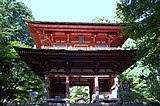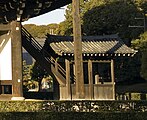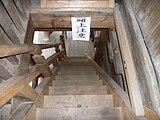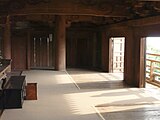|
Nijūmon
 Nijūmon (二重門, lit. two-story gate) is one of two types of two-story mons presently used in Japan (the other one being the rōmon) and can be found at most Japanese Buddhist temples.[1] This gate is distinguishable from its relative by the roof above the first floor which skirts the entire upper story, absent in a rōmon.[2] Accordingly, it has a series of brackets (tokyō) supporting the roof's eaves both at the first and at the second story.[3] In a rōmon, the brackets support a balcony. The tokyō are usually three-stepped (mitesaki) with tail rafters at the third step.[3] A nijūmon is normally covered by a hip-and-gable roof.[2] Unlike a rōmon, whose second story is inaccessible and unusable, a nijūmon has stairs leading to the second story. Some gates have at their ends two sanrō (山廊), 2 x 1 bay structures housing the stairs.[2] The second story of a nijūmon usually contains statues of Shakyamuni or of goddess Kannon, and of the 16 Rakan, and hosts periodical religious ceremonies.[4] Large nijūmon' are 5 bays wide, 2 bays deep and have three entrances, however Tokyo's Zōjō-ji, the Tokugawa clan's funerary temple, has a gate which is 5 x 3 bays.[2] Smaller ones are 3 x 2 bays and have one, two or even three entrances.[2] Of all temple gate types, the nujūmon has the highest status, and is accordingly used for important gates like the chūmon (middle gate) of ancient temples as Hōryū-ji.[3] The sanmon, the gate of a Zen temple of highest prestige, is usually a nijūmon.[note 1] Some nijūmon are called chūmon (中門, lit. middle gate) because they are situated between the entrance and the temple.[2] Gallery
Second storySome interior images of the second story of a nijūmon, in this case Kōmyō-ji's sanmon in Kamakura, Kanagawa prefecture.
NotesReferences
Bibliography
Wikimedia Commons has media related to Nijū-mon. |









